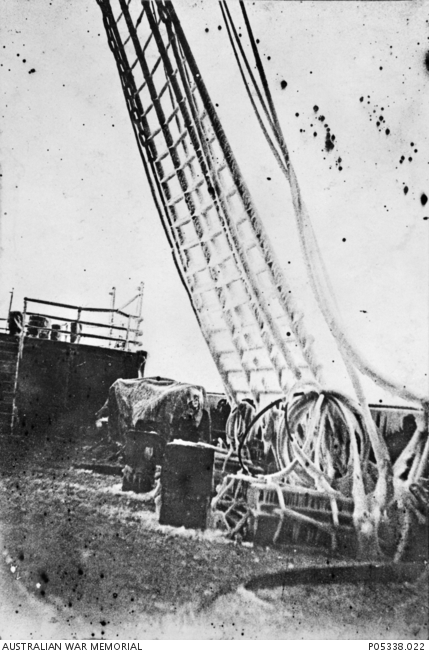| Accession Number | P05338.022 |
|---|---|
| Collection type | Photograph |
| Object type | Black & white - Print silver gelatin |
| Maker |
Unknown |
| Place made | Atlantic Ocean: North Sea |
| Date made | February 1918 |
| Conflict |
First World War, 1914-1918 |
| Copyright |
Item copyright: Copyright expired - public domain
|
Ice covers the deck and ratlines of the German armed merchant raider, SMS Wolf. During February ...

Ice covers the deck and ratlines of the German armed merchant raider, SMS Wolf. During February 1918, the SMS Wolf and her captured prize, the Spanish ship ‘Igotz Mendi’, travelled through the North Atlantic en route for Ruhleben via Iceland. Both ships had been badly damaged when the raider had coaled from the collier mid sea in rough weather. Conditions for prisoners on board both ships were almost unbearable, the temperature reaching as low as minus 10 degree Celsius. Violent storms were encountered with huge waves that constantly washed over the decks. This image is from a collection relating to the voyage of the German raider, SMS Wolf (II), and was taken by an unidentified crew member. Previously a freighter of the Hansa Line, with a gross tonnage of 5809 tons, she was launched as ‘Watchfels’ and was renamed SMS Wolf when she was fitted out as an auxiliary cruiser. She was prepared for her role as an armed merchant ship with an armament that included six 150mm guns, one 105mm gun, three 52mm guns, four torpedo tubes and carried 458 mines, to be placed in Allied territory throughout her journey. SMS Wolf was also provided with an innovative new weapon, the Friedrichshafen FF.33e two seater biplane, an aircraft that was used with deadly success to scout out new targets for attack or to elude enemy threats. The raider was relatively slow, with a top speed of only 11 knots but her bunkers held 8000 tons of coal, giving her a huge cruising range of 32000 nautical miles at eight knots. On 30 November 1916, SMS Wolf sailed from Kiel, Germany, with a complement of 348 sailors and commanded by Fregattenkapitän (Commander) Karl August Nerger. During the 451 days she was deployed in Allied territory around Australia, New Zealand, New Guinea, South Asia and Africa, she destroyed 35 trading vessels and two war ships, amounting to approximately 110000 tons. She returned to Kiel on 24 February 1918 with 467 prisoners of war and substantial quantities of rubber, copper, zinc, brass, silk, copra, cocoa and other essential materials to the German war effort. SMS Wolf, without any support, had made the longest voyage of a warship during the First World War. On her return to Germany, the Kaiser presented every crew member with the Iron Cross and Fregattenkapitän Nerger was awarded the highest German decoration, the Pour le Mérite.
